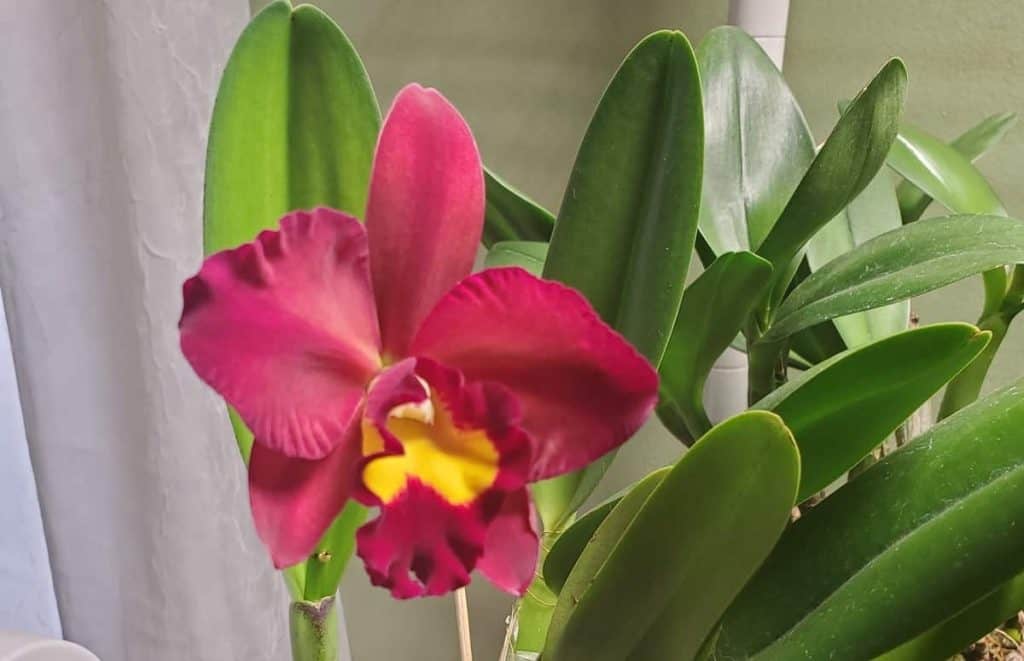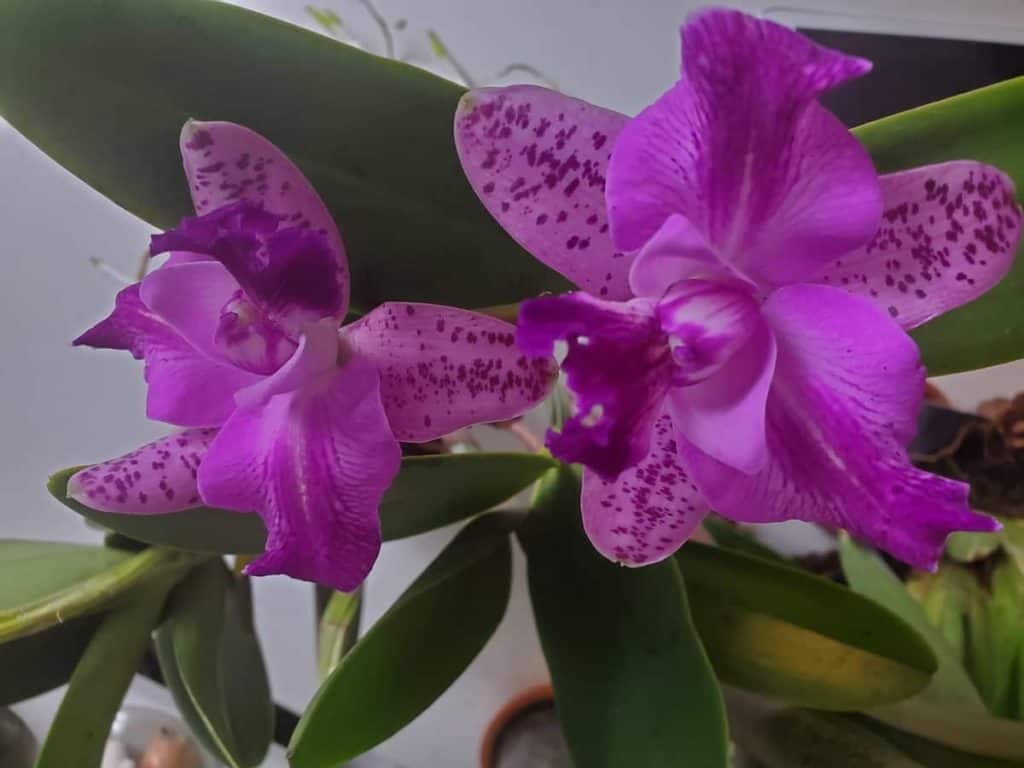Cattleya are common among the tropical and subtropical forests. The original Cattleya (from where the name was derived) came from Pernambuco, Brazil. It can also be found in Costa Rica, Venezuela, Colombia, Peru, Guyana, and Bolivia.
With the spread of information and basic cattleya orchid care, this orchid can find its way into your living room as well, no matter where you live.

Image Credit: © Orchideria 2021
(/ˈkætliə/)
or (KAT-lee-ah)
Funny as it seems, it wasn’t a Brazilian who named the orchid, but a British merchant in 1818. William Cattley held trading posts with several countries, the main trade being with Russia. On one of the packages that arrived from Brazil came a near-dead plant with long white tendrils. Suspecting it was an orchid, William nurtured it back to life. Be it luck, chance, or a divine blessing, one of his cousins, John Prescott was also a horticulturist. Prescott drew many of the orchid drawings in Cattley’s horticulturist books.
After the beautiful orchid bloomed, they sent it to be cataloged by Glasgow Botanical Gardens.
That specific orchid is now known as the Cattleya labiata, (pictured on the right or below if you’re on mobile).
Thanks to this orchid, Cattleyas have spread to be grown worldwide.
It’s easy to learn how to care for cattleyas.
The amazing side of this story is that two men, who knew nothing of this particular orchid’s preferences, tastes, characteristics, or environment, nurtured this plant back from near death. This gives us our first clue that these orchids are not that hard to take care of and can take some beatings—a perfect specimen for new orchid growers!
Quick Care Guide – CATTLEYAS
Sun/Shade: Bright but not direct light
Nighttime Temperatures: 50-53.6 °F (10-12 °C)
Day time Temperature: 77-86 °F (25-30 °C)
Humidity: 40-70%
Hardiness Zones: 10 to 12
Basic Care for Cattleya
Are Cattleyas hard to grow? The simple answer: no. But you have to know what you’re doing. Information is crucial.
To grow a Cattleya orchid, you need to observe 7 basic requirements and conditions. Even though some orchid enthusiasts will agree that phalaenopsis orchids (moth or butterfly orchids) are the easiest for beginner orchid growers, this is the next step up.
With the right information, they can be just as easy as the Phalaenopsis. By observing:
light/shade patterns,
temperature,
air circulation,
watering,
humidity,
potting medium,
and fertilization,
you can cultivate this beautiful orchid and see it bloom your more than 20 years. Let’s get started in cultivating this amazing flower!
1) Cattleya’s Light and Shade Preferences
One of the biggest reasons Cattleyas don’t bloom on their yearly schedule is because of insufficient light. Cattleyas are part of the “bright light” group, by receiving their sun in the early morning or the later part of the day.
The eastern-facing window with soft, morning sun is the best, but if that isn’t available, you can use a southern-facing window too.
In this case, make sure the orchid isn’t getting too much direct sun. The west-facing window tends to be too harsh on the leaves, causing “sunburn.”If you don’t have either east or south, you can use LED grow lights to promote development. In general, Cattleyas prefer brighter light than the phalaenopsis (moth orchids) do. If you have both, place the cattleya closer to the light than the phalaenopsis, which will prefer more shade.
Can Cattleya grow in full sun? No. they need a place that provides more shade than sun, actually. As for shade, Cattleyas like to be 60% of the time out of the direct sun. They still want a bright, well-lit room, but not direct beams.
Don’t keep your orchid in a window that gets sun at all hours—morning, noon, and night. If you live in a climate that is blessed enough to grow orchids outside (lucky you), attach them to the tree that gets more shade than the sun.
Never attach an orchid where direct afternoon beams can scorch it.
To know if the light condition is just right, the leaves will be a pale green. If they are dark, deep green, almost a darker spinach-colored green, then the orchid isn’t getting enough light.
If it’s receiving too much light, the leaves will turn a yellowish-green, and black spots will occur. This could change to a darker red, almost purple color when there hasn’t been enough sun to cause the spotting, but the leaves are still feeling the heat.
2) Best Temperature for Cattleyas
Talking about heat, Cattleyas orchid live in the tropics and subtropics. Warm, baby, warm…
If sunlight was the main cause for not obtaining new blooms each year, then the difference in temperature during day and night is the runner-up, a second-place Cattleya orchid destroyer.
In the rainforest, the daytime temperatures oscillate between 77-86 °F (25-30 °C) year round. This is a bit too uncomfortable to get inside a living room or office space, especially during the summer, but Cattleyas will survive at 72ºF.
The problem isn’t the higher range of temperatures, but the lower range. At night, Cattleyas love a drastic drop in degrees, ranging from 50-53.6 °F (10-12 °C). A few can endure a mid- 40ºF, but none can tolerate frost.
The temperature drop will stimulate flower buds.
If you have a sick Cattleya or for some other reason you don’t want a flower spike, (maybe you’re promoting a better root growth) then keep the temperature constant, at around 70ºF.A good idea is to turn the heat off in the room with the orchid during the summer months. This can get the 15-degree temperature drop that Cattleyas are so desperately looking for. In the summer, keep the Cattleya near a slightly cracked-open window, where the cooler night air will do wonders for your orchid.
During the winter, you might need a heating pad, which promotes the right temperature. You can read more information about heating pads for orchids in this article, or check out the heating pad I bought (Affiliate Link).
3) Air Movement for Cattleyas
When it comes to moving that orchid near a window, another idea would be to take the Cattleyas outside (if your weather permits.) In most of the states in the USA from zones to to 12, this can be accomplished from late May until early October.
In addition to the temperature drop, Cattleyas will like the wind movement. I’m personally not a fan of dragging all my plants in and out each year—too much work. I just keep them inside but have a ceiling paddle fan on low all the time.
Air circulation prevents water droplets from settling on the leaves and in the orchid’s crown. Dead spots occur when water doesn’t evaporate, sitting on the orchid and literally drowning the orchid cells. Also, if there’s a lot of water, fungal and bacterial growth occurs (both of which are hard to get rid of.)
| Kingdom: | Plantae |
| Clade: | Tracheophytes |
| Clade: | Angiosperms |
| Clade: | Monocots |
| Order: | Asparagales |
| Family: | Orchidaceae |
| Subfamily: | Epidendroideae |
| Subtribe: | Laeliinae |
| Genus: | Cattleya |
*The first one, Kingdom, has an interesting website page (not written by me) of several beautiful flowering trees. It’s worth looking at. For adequate air movement, keep a low-running fan on them, night and day. The night-use of the fan is important—just as important as the day-use.
You might be asking, “Why?” Simple.
Leaves “breathe” at night.
During the day, high temperatures provoke the stomata on the leaves to close, trapping humidity inside, along with oxygen and some carbon dioxide.
During gas exchange, there’s always a small loss of humidity, which is natural. But if you’re in a dry environment, which most living rooms are, that loss of humidity could mean life or death.
Think of how you breathe. When you exhale, water droplets leave, too, not only carbon dioxide. Same with the orchid. At night, there’s less of a risk of loosing humidity, since the night air is usually more humid than daytime air.
The loss of humidity is more harmful to the plant than improper gas exchange. This is why respiration occurs at night. A buoyant, cool, moist airflow will promote appropriate gas exchange without dehydrating the orchid.
Another added point to keeping a fan on at night: the leaf temperature drops, which is one of the previous goals. As mentioned before, constant air circulation during summer (or with high temperatures) can dry out low-humidity rooms even more, making the room prejudicial for your Cattleya.
Make sure you also have a humidifier, which brings us to the next topic: humidity.

4) Cattleya’s Humidity Preferences
Cattleyas live in a humid environment, ranging from 40 to 70% humidity. In the average American household, humidity is around 30%. If you use a humidifier but can be comfortable still up to 55%. Above that percentage, there is a risk of growing mold on the drywall and acquiring a respiratory infection.
To please both Greeks and Trojans, aim for a humidity level between 40 to 55%. In greenhouses, this is easier to achieve, but we don’t live in the greenhouse. Our living rooms set to 55% would be almost uncomfortable. You can check out more about how to raise humidity levels in this article.
The higher the humidity level, the higher the air circulation must be. Stagnant, non-moving humidity raises chances for bacterial and fungal infections. You can achieve this by:
Using humidity trays
Grouping plants together
Using a humidifier
Using a top layer of moss
Spraying or misting the room in the morning
Adding other household plants to the room
Even though common advice is to use a humidity tray, and I include it in some of my articles but I have my doubts about the actual humidity it provides.
Recent studies prove that the humidity rises 3 to 4% with humidity trays, and that is only up to 2 inches above the tray.
A humidity tray is a low pan-like tray filled with pebbles, rocks, marbles, gravel, or aquarium rocks. Fill the pan halfway with water, not covering the rocks, then sit the orchid pot on top. The pot mustn’t be touching water or sitting in the water.
Some articles swear by this method. Practical experience says this does *nothing* for the overall humidity. Since the evaporation in these pans dissipates into the environment around one inch above the level of water, it has no overall effect on the room’s humidity levels.
If your orchid is in a small, shorter pot, practically hugging the humidity tray, it might receive some humidity but don’t expect to get a big change in humidity levels. Knowing the poor result rates, other articles advised placing several humidity trays distributed throughout your house and not only one.
I certainly don’t advise investing your money in humidity trays, since you can build your own with common materials lying around your house. I suggest investing in a small humidifier, which can be far more beneficial. The humidifier I use is this one (Affiliate Link) , but I’d prefer you read this article about humidifiers before you purchase one.
, but I’d prefer you read this article about humidifiers before you purchase one.
There are basically four types and I explain each one in detail, so you can purchase the right one for your particular needs.
5) Watering Cattleyas
Watering orchids is a common difficulty among new orchid growers, only because of insufficient information. Once you get the idea and understand why you water the way you do, it’s not hard at all.
In general, no orchid likes to have water in the crown or stem, where water can sit on the leaves. This causes mold to grow, and soon your orchid will rot. This also applies to the roots: don’t water too much leaving time for your orchid to dry out well during watering.
A good method of determining whether or not your orchid needs water is lightly pushing your finger down into the potting medium. If it is humid, don’t water. In doubt, don’t water. If it is totally dry, and you feel no humidity whatsoever, then water.
The goal is for roots to have time to sufficiently dry out. For beginners, start with a pause of 5 days in between watering, but start checking humidity around day 3. Larger Cattleyas like a week’s pause in between watering; younger orchids prefer water twice a week. For smaller pots and miniature orchid plants, this drying time will be considerably less. Start every 3 days. Larger pots will take longer to dry out.
Determiners of how fast a pot will dry are:
Temperature – higher temperatures promote faster drying periods
Air Movement – stagnant air will promote dampness, which can lead to root rot
Light – Direct sunlight will dry out the pot faster
Growth/Dormancy periods – during dormant periods the orchid will absorb less water
Calendar – during winter, water less
As you can see, each orchid will have its specific preferences, and you need to find out what they are. It’s extremely unhelpful if I dictate: water your orchid once a week. As you can tell, there are too many determiners to successfully determine if once a week is right for your orchid.
The potting medium is the number one determiner of how long an orchid will dry out. The more your medium is planted with sphagnum moss and charcoal, the longer humidity will remain in the pot. This is especially good for smaller, younger Cattleyas, but the older they get, the less sphagnum you’ll need to use.

You can use distilled water or rainwater. If your city doesn’t add too many chemicals to your water supply, then normal tap water is fine, too.
To accomplish this, take your orchid to the sink. Open the water to a luke-warm setting, and let water flow on top the potting medium, to the side of the orchid. Never water straight on top of the stem.
6) Cattleya Potting Mix/ Medium
What is the best potting medium? This will depend more on you and your habits and routine. At the greenhouse, sphagnum moss is the usual medium, since they want to sell their plants quickly and don’t individually water each plant. They need a more humidity-soaking potting mix.
At your home, you need to focus on two things in a potting medium.
1) It needs to provide adequate air circulation. Don’t cramp the roots, packing the media down so tight there is no room for air to move freely inside the medium.
2) Drainage. It needs to have a fast water flow, which enters and exits quickly. If you focus on these two things, your Cattleya will splurge in new growth.
Cattleyas prefer a medium-grade potting mix over a finer mix. Since their roots are larger and can handle larger objects in the mix to grip. A finer-coarse material will give them an unstable feeling, and they can topple over easily.
To satisfy this condition, a good addition to your potting medium is fir bark, tree fern fiber, or larger leca pebbles (clay pebbles).
Mounted Cattleyas on cork or driftwood is one of our favorite ways to “pot” orchids. Cattleyas do well to being mounted if you water them every day. The ventilation and freedom by not having their roots cramped inside a pot let them feel more “at home.” If you do mount a cattleya, make sure it is getting sufficient humidity, since it will dry out faster than in a pot.
If your potting media is drying out too fast, and even though you are watering it constantly, you might want to add more sphagnum moss or perlite in a future repot. If your potting mix is constantly humid even after seven days, then you need to add more elements that don’t retain water.

Image Credit: Orchideria.com
7) Potting and Repotting Cattleyas
As to the type of pot, many orchid enthusiasts claim that their Cattleyas prefer clay pots over plastic ones. Although this might be more of a personal preference, I don’t suggest clay pots, especially if you’re a new orchid grower. I explain why in this article. Stick to the plastic pot for now, with lots of slits or abundant holes. You’ll be better off. In two years when it’s time to repot the Cattleya, you can definitely switch to a clay pot.
To repot the Cattleya, if it is in a clay pot, more than likely you’ll need to break the pot. This is better than trying to wedge it out of the pot, ripping and damaging the roots. In a plastic pot, the Cattleya will slide out more easily. Still, wiggle the plant gently, releasing the roots from the sides of the pot before yanking it out.

Choose a pot that will provide 2-3 years’ worth of growth. To estimate this, mimic the space that three pseudobulbs take, add that to the plant, and pick a pot that size. Usually cattleyas grow 1 or 2 pseudobulbs a year.
Don’t overpot: If you choose a pot much bigger than the orchid’s roots, you will stress the plant. It looks to attach itself to the side of the pot. When you place the Cattleya in the new pot, don’t place the rhizome in the middle of the pot. This is a common mistake. Place the older rhizome near the edge of the pot, and the new growths pointing toward the center.
This encourages new roots and provides plenty of space for new growth, as it fills up, crawling toward the other side of your pot. The older rhizomes will not be harmed by placing them next to the side of the pot. They won’t be growing that many roots as compared to the newer growth.
8) Dividing Cattleya Orchids
How do you transplant a Cattleya orchid? If you have a bigger cattleya and want to divide it, select three or four pseudobulbs on the rhizome and divide only after those. Any rhizome with only two pseudobulbs will not have enough energy to provide sufficient growth and will probably end up dying after being divided.
Wait until the orchid has finished blooming and all the flowers have fallen off. For most cattleyas, this means in the late spring. Once the flowers fall, the dormant cycle begins and Cattleyas will not need much energy to promote growth.
Important tip: Extra humidity is essential right after dividing and repotting a Cattleya, so turn up the humidifier or use a top layer of sphagnum moss. Humidity is wonderful, water is not. Don’t water the Cattleya for a week after repotting. If you soak the potting mix before you use it, then this is sufficient for water supply. Also, at this stage, the risk of infection is greatly increased. Water makes it worse.
Another tip: always use sterilized utensils. You can use alcohol, a flame, or any other common knowledge way of sterilization. Don’t trim or cut one orchid, then another one, then another… Always sterilize after cutting, trimming, dividing, etc.
Once the open “wound” of the cut, apply cinnamon, the type you use use in your ktichen; the same cinammon sold in grocery stores. Cinnamon is a natural healer. Some articles go as far as saying it is antibacterial, but we’ve had no proof of that. It does wonders, but not miracles.
I wrote an entire article that explains using cinnamon more in depth. Click here to read that article.
If you are just interested in pruning Cattleya so they can grow more pseudobulbs (which later means more blossoms, then this article is better. Sometimes we don’t want to divide them, but just give the Cattleya orchid a little boost that will influence the number of pseudobulbs that it grows.
9) Feeding/ Fertilization for Cattleyas
When picking a fertilizer for Cattleyas, choose one that has a lower concentration and is balanced, for example, a 10-10-10 or 13-13-13. Always dilute the fertilizer to ¼ of what the instructions recommend.
Whatever fertilizer you end up choosing, make sure it is urea-free. There is more information about fertilization in this article, but it is a general article applied to all orchids. Cattleyas will need less fertilizer.
Some orchid enthusiasts fertilize “weekly, weakly”, which means once a week with an extremely small dose. We prefer to wait out the fertilization, since Cattleyas don’t need that much, compared to phalaenopsis. Every other week or a misting spray is our preferred method.
Too much fertilizer causes root burn and will promote salt build-up on the top of your potting medium. In Cattleyas, if you happen to over-fertilize and the roots aren’t burned but absorbing the chemicals well, this will promote abundant leaf and root growth, hindering the flower production.

There are reasons to temporarily hinder flower production.
This might be what you’re aiming for if your orchid roots are damaged and you’re trying to nurture them back to life.
Maybe your Cattleya got severely sunburned and you’re trying to recuperate the plant, in determent to see a beautiful flower this season.
If this is the case, use your fertilizer constantly, just avoid root burn, and only do this for a temporary period.
Tip: If your Cattleya’s leaves are dark green yet still getting appropriate light, it might mean there is too much nitrogen in your fertilizer. On the other hand, if you are using a lot of fir bark, in the potting medium, you’ll need to supplement. Use a fertilizer with a higher nitrogen count, like 30-10-10 since fir bark retains more nitrogen from the atmosphere than other material like clay pebbles.
9A) Fertilization in Dormant Seasons
There are two types of Cattleyas when it comes to fertilization: those that bloom year-round and those which go dormant.
If your Cattleya has a dormant cycle, blooming only once a year, then you’ll need to cut back on water and fertilization during this dormant cycle (usually this coincides with winter, but observe your plant to make sure). The dormancy cycle could be only a few weeks, too.
Some Cattleyas go dormant for up to a few months. Don’t think in terms of six months, but a shorter period.
If your Cattleya blooms all the time, keep up the light, fertilizer, and watering to a normal schedule, never cutting down. To observe when the Cattleya leaves the dormancy cycle, you’ll see new roots starting to shoot out from the stem.
Don’t Stop Learning!
If you want to be included in more information and get a 14-page fertilization guide, please sign up for my newsletter. I don’t spam, but send emails out bi-monthly with some curious topics of interest. If you want more information, click here to go to a specific page on this website where I explain it more in detail.

Also, if you are looking for an orchid journal to keep your notes specifically about orchid care, check out my 2 solutions for that on this page. If note-keeping isn’t your thing, then there is a free excel spreadsheet that you can download. Click here for more information on how to do that.
If you subscribe to my newsletter, I will send you a 14-page guide on the main tips of orchid fertilizer. It is downloadable and you can print it out on your computer. I designed the guide to double up as a coloring book, just to make it fun.

What Time of Year Does Cattleya Bloom?
Most cattleyas produce only one flower blossom a year, usually toward the end of summer or late winter. For floral design, this is extremely useful to know, because you can plant two together, a summer bloomer and a winter bloomer.
Your orchid design will have flowers year round, and not just leaves. While one is in bloom, the other is getting ready to produce buds.
Note: Some Cattleyas don’t have a scent, but when they do… Oh my!! Cattleyas are what usually comes mind when we thinking of orchids, with the moth orchid (Phalaenopsis) in second place. For the longest time, they were the number one selling orchid in the USA, but due to how much longer the moth orchid keeps their flowers (up to 4 months) they have lost that ranking.
If you want more information on how to rebloom a Cattleya, (specifically how to prune it so it will produce more pseudobulbs which in return will grow more flowers) click on this article that I wrote which explains that process in more detail.
How Long do Cattleya Blooms Last?
One to three weeks is usually how long the majority of Cattleyas will stay open and in bloom, but there are so many varieties that this answer is subjective. Even though Cattleyas are slow growers—five to seven years from seed to a mature adult—their flowers are well worth the wait.
Further Reading Suggestions:
Don’t just take my word for what is written here. Continue researching other articles about Cattleya Care, because everyone has a different point of view and unique techniques that work for them. Here are a few other articles from other websites if you’d like to continue your research on cultivating Cattleyas:
–Title: “Care of Cattleya ” written by Smithsonian Institute, includes a summary of the main topics presented here.
” written by Smithsonian Institute, includes a summary of the main topics presented here.
–Title: “Culture Sheet for Cattleyas ” written by AOS, American Orchid Society has a detailed page of information on Cattleyas.
” written by AOS, American Orchid Society has a detailed page of information on Cattleyas.
–Title: “Cattleya Orchids “ written by Sandra Tuinstra, published on NDSU talks about different aspects of orchids, not properly their care, but their story.
“ written by Sandra Tuinstra, published on NDSU talks about different aspects of orchids, not properly their care, but their story.
Now that you know all about Cattleyas, in terms of temperature, light, shade, humidity, flowering, repotting and fertilization, how about some more articles about Cattleya orchids?
- How To Prune a Cattleya: 4 Steps For More Blossoms

- How to Divide Cattleya Orchids: 5 Steps for Success
- What are Sheaths? Learn to Encourage Blossoms in Cattleyas
If this information was of any help or clarified any doubts you had, please mention so in the comments. We love to interact with other orchid enthusiasts, and can share from our experiences. Share this page with a friend who has an orchid, comment, or give me a thumbs up 😊 in the comments below.
Happy cultivating!

Orchid care is my passion, and I hope it shows in my writing. With over 5 years of experience in writing numerous articles and researching about orchids, 2 published books in orchid-care, and being a landscape designer in the Brazil where I incorporate orchids both in indoor and outdoor spaces, I write every article on Orchideria myself. My vision is for every person who owns an orchid to fall in love with how it is cultivated and find peace by immersing themselves into the world of orchid care. You can trust what you are reading since every single article on my website is unique and backed up by books, reviews, articles, studies, and tests. I offer in-depth and reliable information for all orchid growers, experts and beginners alike.

What do I do if my Cattleya flower bulbs has holes before they even bloom?
Hi Janet,
It’s not normal to have holes before they bloom. My guess is that this is caused to a household pet chewing on the leaves, but some bacteria can have the same effect. If you are certain that no animals are bitting the bulbs, then isolate your orchid and look for smaller insects. If this is also not the problem, then treat it with physan 20, which usually takes care of most the “unknown caused” bacterial and fungicide problems.
-Amanda
My Cattleya is in a dormant stage and lives on my lanai in Southwest Florida. The older leaves have large black spots and one leaf is turning yellow. Is this a fungus? Also it is planted in tightly packed stones. I bought it at an orchid show last year and have not repotted it. Can you help?
Hi Patricia,
The yellowing leaf is probably normal and nothing to be worried about. If it the oldest leaf on your Cattleya orchid, it will eventually die off leaving only a pseudobulb. If it is a younger leaf, then that is worrisome. I’d treat it because there shouldn’t be any drastic color changes on Cattleyas. As for the black spots, how big are they? Are they pencil eraser type dots or big blotches of widespread discoloration? I certainly would start with a treatment like Physan 20 if they are big ad growing since that product kills most all bacterias that infest orchids. Some Cattleyas will have tiny blackish-purple “freckles” and that is normal, but if the dots ar bigger than that, I’d certainly treat it. Also, take note of how fast the spots multiply. If they appear but do not spread, it is ok and normal. If they start to take over the leaf and spread to other leaves, then it’s a big problem. On this page, https://orchideria.com/best-insecticides/ there is a list of what I use for each ailment. Hope it helps.
How long does it take young Cattleyas to bloom? I’ve only had my baby just over a year. It has produced 2 leaves and some roots.
hellow from Zimbabwe – loved your article!
Llynlongwell@gmail.com. very helpful, l please put me on your mailing list. I live near Hausermans Orchids.
n a Orchids
my friend as beautiful blossoms on her cattlyla, however one of the blossoms is without a lip. What might have caused this?
my orchid has had eight gorgeous blooms, three are left and soon will fall, sadly. I bought the plant a year ago May in full bloom, watered it for the year and it finally bloomed third week of May this year. What do I do now with the plant to keep it alive and well for another year? Do I remove any leaves, stems?
I have most of my Catleyas in two hanging baskets. They have bloomed beautifully for the past 6 to 10 years. This year is the first year that there are several blossoms growing from the top of the new stems without a sheath. Is this a rare occurrence? The buds have or are filling out like those from a sheath. Just curious as I’ve not observed this happening before.
I live in central Florida and the orchids stay outside unless the temp drops below 40F.